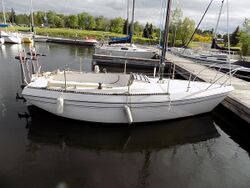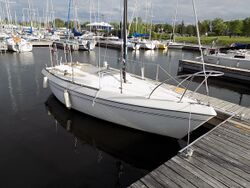Buccaneer 200
Topic: Engineering
 From HandWiki - Reading time: 3 min
From HandWiki - Reading time: 3 min
 | |
| Development | |
|---|---|
| Designer | Alan Payne |
| Location | United States |
| Year | 1974 |
| Builder(s) | Bayliner |
| Boat | |
| Boat weight | 2,100 lb (953 kg) |
| Hull | |
| Type | Monohull |
| Construction | Fiberglass |
| LOA | 20.42 ft (6.22 m) |
| LWL | 17.33 ft (5.28 m) |
| Beam | 8.00 ft (2.44 m) |
| Hull draft | 17.33 ft (5.28 m) |
| Engine type | Outboard motor |
| Hull appendages | |
| Keel/board type | long keel |
| Ballast | 750 lb (340 kg) |
| Rudder(s) | transom-mounted rudder |
| Rig | |
| General | Masthead sloop |
| I (foretriangle height) | 25.80 ft (7.86 m) |
| J (foretriangle base) | 7.60 ft (2.32 m) |
| P (mainsail luff) | 22.00 ft (6.71 m) |
| E (mainsail foot) | 8.30 ft (2.53 m) |
| Sails | |
| Mainsail area | 91.30 sq ft (8.482 m2) |
| Jib/genoa area | 98.04 sq ft (9.108 m2) |
| Total sail area | 189.34 sq ft (17.590 m2) |
| Racing | |
| PHRF | 276 (average) |
The Buccaneer 200 is an American trailerable sailboat, that was designed by Alan Payne and first built in 1974.[1][2][3]
The Buccaneer 200 is a development of the Columbia T-23 design, using the same tooling to build the hull.[1]
Production
The boat was built by Bayliner Marine Corporation in the United States starting in 1974, but it is now out of production.[1][2][4]
Design
The Buccaneer 200 is a small recreational keelboat, built predominantly of fiberglass, with wood trim. It has a masthead sloop rig, a transom-hung rudder and a fixed long shoal-draft keel. It displaces 2,100 lb (953 kg) and carries 750 lb (340 kg) of ballast.[1][2][5]
The boat has a draft of 1.75 ft (0.53 m) with the standard keel, allowing beaching or ground transportation on a trailer. It is normally fitted with a small outboard motor for docking and maneuvering. The cabin is small but includes a double berth, a quarter berth, galley with a sink and a fold down table. Cabin headroom is 42 in (110 cm).[1][5]
The boat has a PHRF racing average handicap of 276 and a hull speed of 5.58 kn (10.33 km/h).[2][5]
Operational history
In a 2010 review Steve Henkel wrote, "Best features: The competition in this size and weight range was fierce in the 1970s, and to clearly differentiate their product, Bayliner went for low price, a wide beam for plenty of space below, and a simple-to-use boat. Then, as now, this attracted the non-sailing public as buyers. Neophyte sailors found a vessel with a low first cost, and a shallow keel for easy launching and retrieving on a trailer ramp. The long keel also enables the hull to track well under power or when going downwind ... Worst features: The new sailors would also find eventually that a boat with a shallow keel tends to side-slip when sailing upwind in a light to moderate breeze. A long, narrow centerboard housed within the keel (such as on the Chrysler 20) would have eliminated that shortcoming, but would raise the price and complicate sailing."[5]
See also
Related development
Similar sailboats
- Cal 20
- Com-Pac Sunday Cat
- Chrysler 20
- Drascombe Lugger
- Drascombe Scaffie
- Halman 20
- Hunter 18.5
- Hunter 19-1
- Hunter 19 (Europa)
- Mercury 18
- Naiad 18
- Paceship 20
- Sandpiper 565
- Sanibel 18
- Santana 20
- Siren 17
References
- ↑ 1.0 1.1 1.2 1.3 1.4 Browning, Randy (2017). "Buccaneer 200 sailboat specifications and details". sailboatdata.com. https://sailboatdata.com/sailboat/buccaneer-200.
- ↑ 2.0 2.1 2.2 2.3 InterVisionSoft LLC (2017). "Sailboat Specifications for Buccaneer 200". Sailing Joy. http://www.sailingjoy.com/sailboat_specs/sailboat_specs/view/184/buccaneer-200.
- ↑ McArthur, Bruce (2020). "Alan Payne 1921 - 1995". sailboatdata.com. https://sailboatdata.com/designer/payne-alan.
- ↑ McArthur, Bruce (2020). "Bayliner (Buccaneer/US Yachts) 1970 - 1979". sailboatdata.com. https://sailboatdata.com/builder/bayliner-buccaneerus-yachts.
- ↑ 5.0 5.1 5.2 5.3 Henkel, Steve: The Sailor's Book of Small Cruising Sailboats, page 87. International Marine/McGraw-Hill, 2010. ISBN:978-0-07-163652-0
External links
 |
 KSF
KSF

